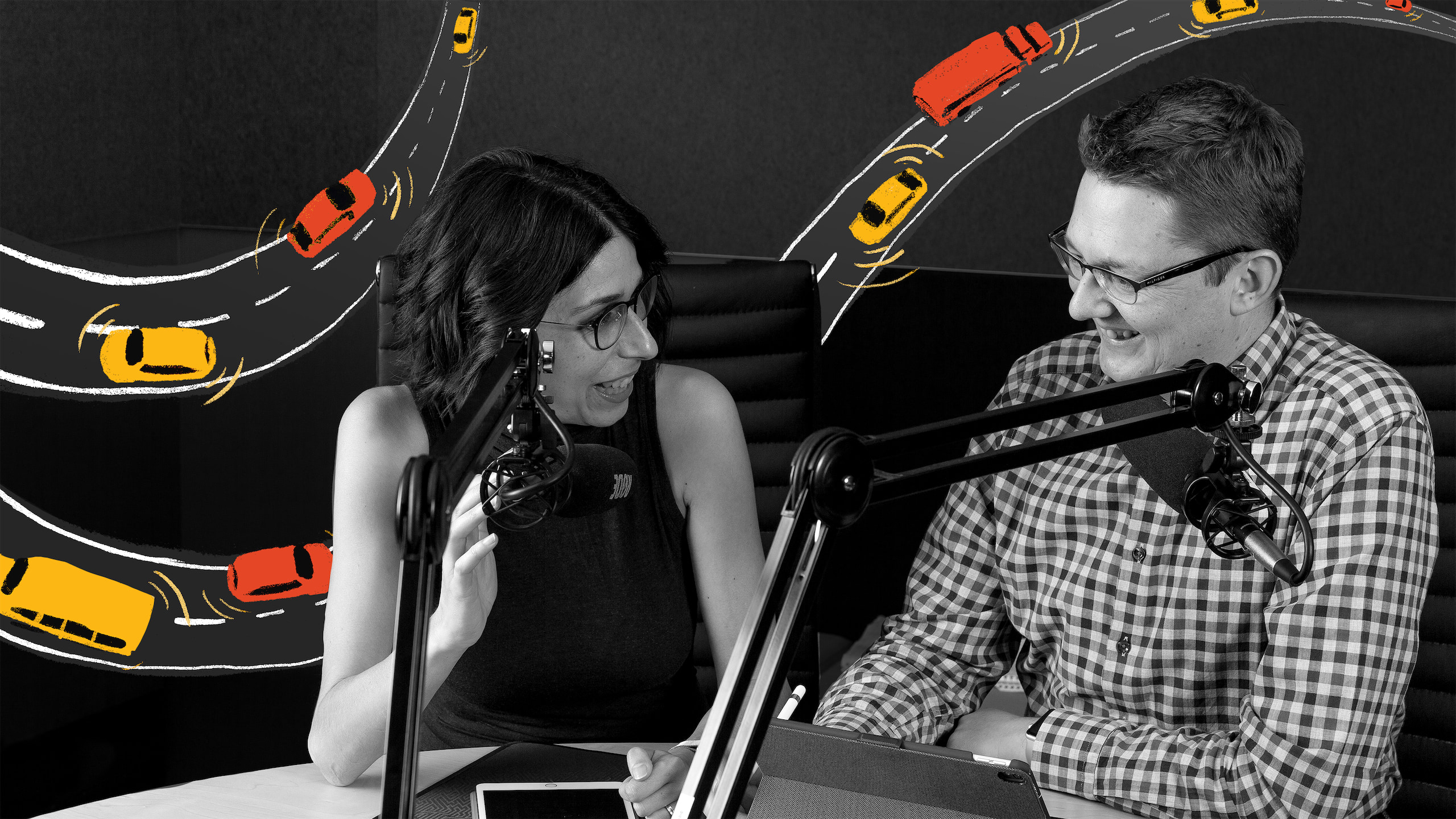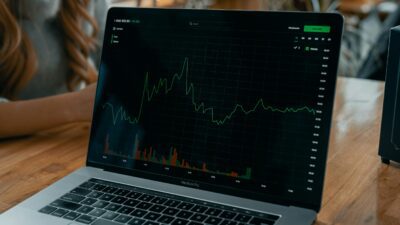Sandra Peter and Kai Riemer

The Future, This Week 01 June 2018
This week: putting solar on the map, batteries have a dirty secret, and buses. Sandra Peter (Sydney Business Insights) and Kai Riemer (Digital Disruption Research Group) meet once a week to put their own spin on news that is impacting the future of business in The Future, This Week.
The stories this week
You can see China’s solar farms from space
Electric buses are hurting the oil industry
Other stories we bring up
Morocco’s giant Sahara thermosolar farm
China’s solar might be too much of a good thing
What happens when we consume more solar than we can use?
China’s BYD has overtaken Tesla in the battery and electric car business
The idea of leapfrogging, previously discussed on The Future, This Week
You can subscribe to this podcast on iTunes, Spotify, Soundcloud, Stitcher, Libsyn or wherever you get your podcasts. You can follow us online on Flipboard, Twitter, or sbi.sydney.edu.au.
Our theme music was composed and played by Linsey Pollak.
Send us your news ideas to sbi@sydney.edu.au.
Dr Sandra Peter is the Director of Sydney Executive Plus at the University of Sydney Business School. Her research and practice focuses on engaging with the future in productive ways, and the impact of emerging technologies on business and society.
Kai Riemer is Professor of Information Technology and Organisation, and Director of Sydney Executive Plus at the University of Sydney Business School. Kai's research interest is in Disruptive Technologies, Enterprise Social Media, Virtual Work, Collaborative Technologies and the Philosophy of Technology.
Share
We believe in open and honest access to knowledge. We use a Creative Commons Attribution NoDerivatives licence for our articles and podcasts, so you can republish them for free, online or in print.
Transcript
Disclaimer: We'd like to advise that the following program may contain real news, occasional philosophy and ideas that may offend some listeners.
Intro: This is The Future, This Week on Sydney Business Insights. I'm Sandra Peter. And I'm Kai Riemer. Every week we get together and look at the news of the week. We discuss technology, the future of business, the weird and the wonderful, and things that change the world. Okay let's start. Let's start.
Kai: Today on The Future, This Week: putting solar on the map, batteries have a dirty secret, and buses.
Sandra: I'm Sandra Peter, Director of Sydney Business Insights.
Kai: I'm Kai Riemer professor at the Business School and leader of the Digital Disruption Research Group. So Sandra what happened in the future this week? Oh wait Sandra is on holidays this week so it's just me but lucky enough we have pre-recorded this segment for you. So Sandra and I sat down a couple of weeks ago and recorded a special on renewable energy with a few stories that we wanted to catch up on that we didn't fit into the regular schedule. So here is us.
Sandra: There were a few stories on renewables that we've missed over the last few weeks and the first one is about how you can actually start to see the boom of solar power from space. One of the stories from Mashable Australia reports on China's solar power that has surpassed all predictions. China now attracts over 48 percent of the global investment in clean energy.
And the article reports on one of its installations that was ranked the largest solar installation in the world with about 10 square miles of one of the Chinese provinces being covered in solar panels. A similar story was actually reported by PBS as well but this time it's in Morocco.
Kai: So part of Morocco is the Sahara Desert and Morocco is now making good use of that space by covering it with a series of really large solar projects.
Sandra: Such as Noor which in Arabic means light which is a nine billion dollar energy plant meant to make Morocco the Saudi Arabia of solar energy.
Kai: And while it is not quite the size of Paris as the World Economic Forum enthusiastically reported, these installations are really big. So big is the added capacity in solar in places like Morocco and China in particular that experts are actually worrying that it might have negative effects on the grid. So MIT Technology Review reports that China is installing "a bewildering and potentially troublesome amount of solar capacity". So China apparently has installed about 10 gigawatts of solar capacity in the first quarter of 2018 alone. That's up from around 7 in the same period during the past two years and Bloomberg New Energy Finance pointed out last year that there can be too much of a good thing and that the grid in China if not extended quite substantially might actually start to get unstable. And similarly just last month's ABC News reported that Australia is now at a point where we're producing so much solar in some parts of the country that it might actually turn the grid to shit on a very sunny day.
Sandra: So while these first couple of stories really talk to how the renewable energy space continues to be the fastest growing segment of the energy sector, it also started to point a couple of downsides around the economics of renewables and to the fact that actually the story of making renewables like solar mainstream is actually slightly more complicated. So besides the expected downsides of costs or logistics or technology that might not be mature enough there are real difficulties with integrating this into the systems that we already have. And usually the solution that is offered at this point is batteries. But even that story is actually not as simple. So another one of the stories we didn't get a chance to cover over the last few weeks comes from Vox and actually tries to go a bit deeper into whether or not batteries are actually an answer to this conundrum. It's called "Batteries have a dirty secret" and it looks at energy storage that is considered the green technology and how it might actually increase carbon emissions as a solution to storing the excess energy from solar plants.
Kai: And so while batteries are often heralded as a solution for storing excess energy from renewables production be it wind or solar, so we're producing more solar at certain times of the day so much so that it might actually overload the grid, batteries come in handy here because they can store that solar energy during the day and then we can use that at night. So this is the story of batteries as it is commonly told and was in the news in Australia with Elon Musk's promise to build the South Australian battery plant, the largest one in the world at the time and they did this successfully. What we want to look at is the use of batteries in particular in the US in particular in areas where renewable energy isn't as far advanced yet as it might be in China or Australia.
Sandra: The article reports on research by the Rochester Institute of Technology and Carnegie Mellon that appeared in Environmental Science & Technology and what it tries to do is it tries to model energy mixes and energy prices across the US. What the article determines is that actually the deployment of batteries increases emissions almost everywhere across the country.
Kai: Now this is a counterintuitive finding given that batteries are always discussed in the context of solar and renewables so how can it be that deploying batteries is actually increasing emissions rather than decreasing emissions. And so the article takes a deeper look and it turns out that in the US the most common use for batteries is actually for energy arbitrage rather than the storage of renewable energy. So energy arbitrage means that we're storing energy when it is cheap usually at night and we're discharging it when it is more valuable usually during the day. Now obviously solar is not produced during the night. And what is going on here is that batteries are frequently used to buy cheap coal powered energy during the night and then store it and discharge it when prices are at a peak during the day. Now the problem here is now that there's a net effect whereby cheaply produced fossil based energy competes with solar energy during the day not only delaying the effect of solar but also leading to the production and use of more fossil fuel based energy and therefore the emission of more carbon.
So what that means is that batteries are actually used to make fossil fuels more economical because providers to buy these batteries have a far greater use economically using them that way than through the use of solar or wind energy which in many parts of the US are not actually that widespread and the problem is aggravated by the fact that whenever we store energy we lose some energy. So it means that when we are producing fossil based energy during the night and store it in the battery we're losing about 20 percent of its efficiency and then have to produce more energy in the process.
Sandra: So what this tells us is that timing and speed are of the essence. Timing first of all in case battery technology actually develops very quickly and you bring it in before you have enough renewable resources the batteries can act as a barrier to adoption of renewable energy.
Kai: Because it makes the use of fossil fuels cheaper and therefore extends the competitive effect of this energy mix against solar and wind that you're trying to bring into the market.
Sandra: On the other hand as we've seen with our first story you don't want to develop renewables too quickly as well because there is a risk in overloading the grid and not actually being able to fully utilise the capacity that you've created as we've seen for instance with a couple of other stories we've previously discussed with Germany having to export a lot of its renewable energy.
Kai: The good news is though with the research discussed in the Vox article is that the negative effect of batteries on carbon emissions decreases markedly the more the energy mix is actually green. To the point where at some point battery storage has the expected positive effect where it is actually used for the storage of renewable energy.
So you don't want to have batteries in the market too early unless and here is where regulation comes in, not regulation in the form of states and governments telling players what to adopt but actually designing an effective market system where the article argues that if the market is designed such that it takes account of carbon emissions and the cost attached to that. In other words if there is a price of carbon in the market that effect that batteries are having can be reduced markedly so it depends on how the regulators are actually setting market conditions so that things can play out in the desired way reducing carbon emissions as we adopt these technologies.
Sandra: What we wanted to highlight with this story is really that batteries and energy storage as well as energy sources such a solar or wind are actually pieces of a very large puzzle. There are not unqualifiedly good and the more we have the better it is but they depend on the number of factors especially when they're deployed, at what speed, where and what other policy incentives exist as well as the human factor in the mix. Whilst in the long term it might be beneficial for us to adopt renewable energy sources the players in the market optimise for short term gain.
Kai: And this is why it is important that if we want to achieve the climate change goals, at a timeline that is necessary, regulation has to come in but we don't have to think about regulation as governments mandating or prescribing adoption of certain energy mixes but rather as the careful design of the market in which players operate.
So we need to get away from the idea that the market is what happens when everyone is left to their own devices because all markets are regulated and all markets are designed in some way. And so in this instance here it is about bringing into play the true cost of energy and that includes a carbon price for example. Which if included would do away with the effect that batteries are mostly used for arbitrage.
Sandra: Which brings us to our last story, which is on buses. The last story is from Bloomberg and it's called "Electric buses are hurting the oil industry". Turns out because of electric buses almost 300,000 barrels a day of fuel won't be used, won't be needed in 2018 and China again is leading the way here. We started with a story on China and how China is leading the way with solar energy. Turns out they're even further ahead in the electric bus space. China adds a London sized electric bus fleet every five weeks. So let's have a closer look at the numbers here. The numbers reported in the Bloomberg article are quite staggering. So Kai and I found out that China actually has about 99 percent of all the electric buses in the world and the electric buses in China account for about 17 percent of China's bus fleet. And every five weeks it adds about nine and a half thousand zero emission buses.
Kai: That compares with about 344 electric or hybrid buses in the U.K. in total. Germany as the next largest operator of electric buses has less than 300 electric or hybrid buses. And so if we compare those numbers, China's got about 10 times the number of people compared to the U.K. and Germany combined. But six hundred times as many electric buses. So that's off by an order of magnitude almost, considering that we often think yes sure China has lots of people so they must have more of everything. This is not just more of everything, this is significantly larger numbers of deployment of electrical buses so China is far far ahead in the adoption of these vehicles than the rest of the world.
Sandra: So China is clearly ahead and trying to electrify its fleet because it does have the world's worst pollution problem especially in these rapidly growing cities. So one of the pilots was started in Shenzhen more than 10 years ago which attempted to make Shenzhen a zero emission public transport area in 2009. Only a couple of years later, Shenzhen's over 16,000 buses were all electric. So whilst places like Paris and London and Mexico City and L.A. are all looking and committed to get to zero emissions public transport by 2025 or 2030 or 2035 they are doing this much much slower. As we've said before, the U.K. has only managed so far three hundred and forty four that is electric AND hybrid buses in 2017.
Kai: And this is where we need to talk about a concept that we've previously touched on in the podcast and that is leapfrogging. So leapfrogging is the idea that as technologies develop countries who come to the party a bit later than others can actually jump ahead and leave out a whole generation of technology and go straight to the newest technology.
So in the case of China that means that while they have a pollution problem that is created by the first generation of car technology, they are going straight to electric vehicles for solving that problem. While the West has gone to cleaner filter based combustion engine technology whereby you could solve the pollution problem largely by adding filters to regular cars which means there's no immediate need for the local population apart from the diesel scandal maybe but there's not the same immediate need to replace the current fleet of buses and cars to solve the kind of pollution problem that China is grappling with, while at the same time those cars are still emitting carbon adding to climate change. So by getting rid of the pollution problem China at the same time makes big progress in the fight of climate change as well, growing its fleet of public transport with technology that not only solves the pollution problem but also helps to fight climate change.
Sandra: And before we finish the story there is just one other aspect we need to bring up and that is what plays out in the background of the story of the many electric buses in China because the company making all these buses, the Shenzhen based BYD company which is actually an acronym for Build Your Dreams is also one of China's largest producers of batteries. Berkshire Hathaway actually owns about 8 percent of BYD which whilst producing 17 percent of China's electric bus fleet is also one of the biggest producer of home batteries and they also sell to Australia but obviously do not have the brand recognition that Elon Musk's Tesla has. The output of BYD actually dwarfs what Elon Musk and Tesla have managed to achieve. And whilst the sale of electric buses is what is usually covered when we talk about BYD their battery production is actually quite astonishing. While we've spent quite a bit of time talking about Tesla's Gigafactory opening last year it's good to remember that BYD actually managed to achieve the same thing more than four years ago which actually makes it the world's largest battery and electric vehicle maker.
Kai: And that is all we have time for today.
Sandra: And I'll be back in two weeks just in time for Vivid. The last tickets are going now so please grab one and come see us on the 16th of June at the MCA for "Mummy, can I marry my Avatar?" together with Mike Seymour, Rachel Botsman, Kai and myself.
Kai: And join us again for another special on Facial Recognition this time in The Future, This Week next week. Thanks for listening.
Outro: This was The Future, This Week made awesome by the Sydney Business Insights Team and members of the Digital Disruption Research Group. And every week right here with us our sound editor Megan Wedge who makes us sound good and keeps us honest. Our theme music is composed and played live from a set of garden hoses by Linsey Pollak. You can subscribe to this podcast on iTunes, Stitcher, Spotify, SoundCloud or wherever you get your podcasts. You can follow us online on Flipbook, Twitter or sbi.sydney.edu.au. If you have any news that you want us to discuss please send them to us at sbi@sydney.edu.au.
Close transcript







